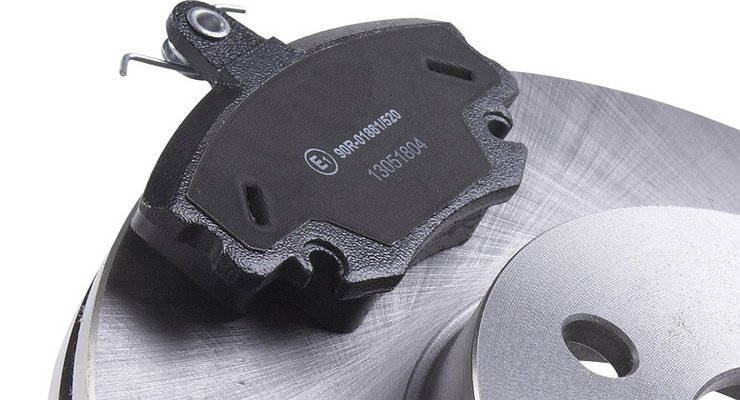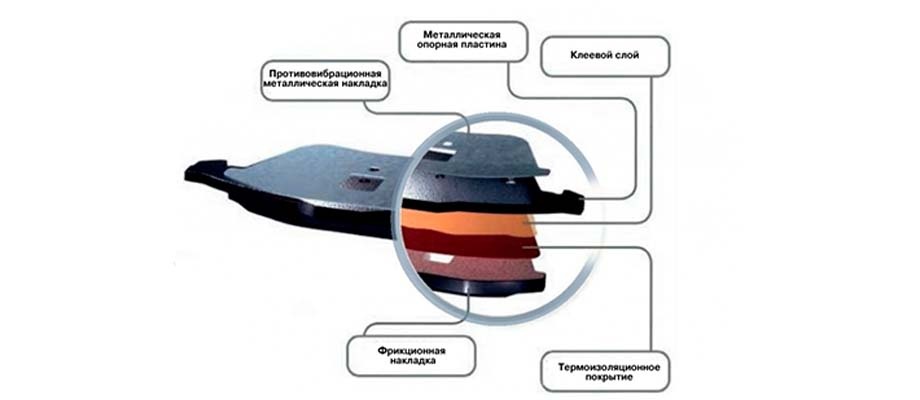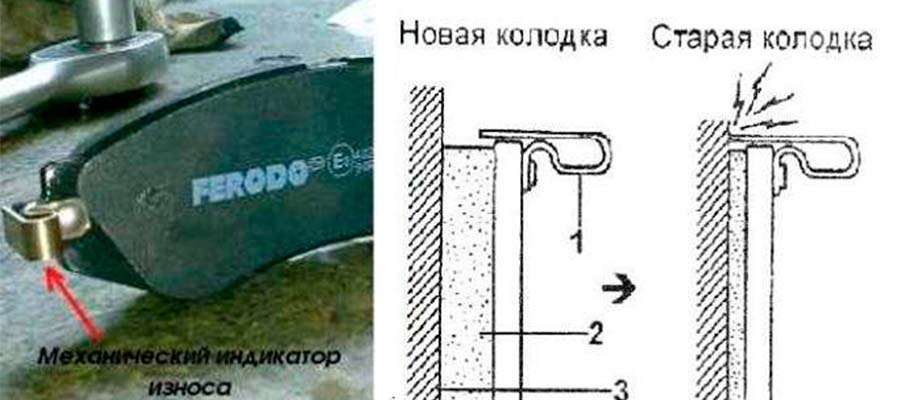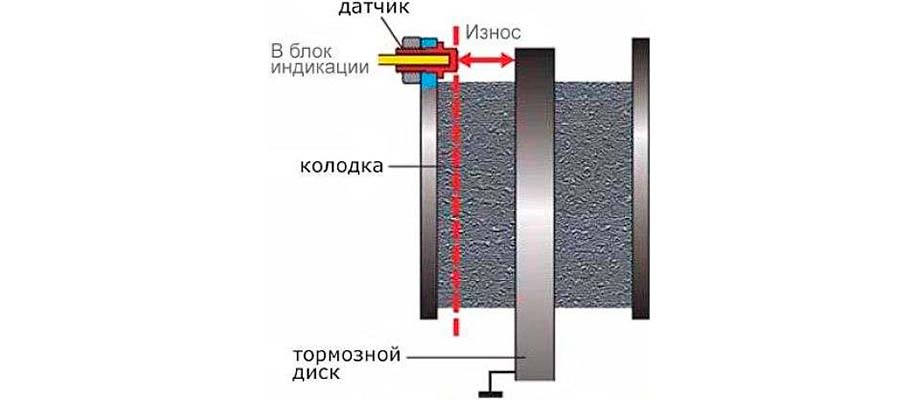
Brake pads. What you need to know
In modern vehicles, two types of brake mechanisms are used - disc and drum. In both cases, the friction method of braking is used, in which the deceleration of the rotation of the wheels occurs due to the interaction of friction pairs. In such a pair, one of the components is movable and rotates with the wheel, the other is stationary. The moving component is the brake disc or drum. The fixed element is the brake pad, which will be discussed in this article.
During braking, fluid pressure is created in the hydraulic system or compressed air if pneumatics are used as a drive. The pressure is transferred to the working (wheel) cylinders, and their pistons, moving forward, act on the brake pads. When the pads are pressed against a disk or drum rotating with the wheel, a friction force arises. The pads and disc (drum) heat up. Thus, the kinetic energy of the car's movement is converted into thermal energy, the speed of rotation of the wheels decreases and the vehicle slows down.
Pads for disc brakes differ in shape. In disc brakes they are flat, in drum brakes they are made in the form of an arc. The shape is determined by the surface with which the pads are in contact - the flat side surface of the disc or the inner cylindrical working surface of the drum. Otherwise, there are no fundamental differences in their design.
The basis is made by the metal bearing plate. On the non-working side, it has a damping primer to dampen vibrations and noise. In some designs, the damper can be made in the form of a removable metal plate.

A friction lining interacts directly with the disc or drum, which is attached to the base with a special adhesive or with rivets. It happens that the lining can be removable, but in most cases the block changes entirely.
The lining is the most interesting part of the brake pad. Braking efficiency, as well as the service life and price of the pad itself, largely depend on its parameters and workmanship.
There is a thermal insulation layer between the friction layer and the support plate. It protects from excessive heating and from boiling.
Often, chamfers and one or a set of slots are made on the working side of the pad. Chamfers reduce vibration and noise, and slots serve to remove dust, and also improve heat dissipation.
A lapping coating is often applied on top of the friction layer for faster adjustment to disc irregularities.
To help the driver understand that the block has reached a critical degree of wear, many manufacturers supply it with a mechanical signaling device, which is a metal plate fixed to the end. When the friction layer is severely worn, the edge of the plate will begin to touch the brake disc and emit a characteristic loud squeal.

Recently, to control the degree of wear of the pads, electronic sensors are used, when triggered, the corresponding light on the dashboard lights up. They can be external or built-in. In the second case, to change, you need to purchase pads with integrated sensors.

The main requirement for linings is to provide sufficient braking performance in all road conditions, including mud and high humidity. It is moisture that presents the greatest problem for the normal operation of the brake pair, playing the role of lubricant and reducing the coefficient of friction.
The pads must retain their working properties in severe frost, withstand sudden temperature changes and significant heating, which during friction can reach 200 ... 300 ° C and more.
Noise characteristics are also of great importance. About a hundred years ago, when disc brakes were invented, the pads did not have pads and the friction of metal on metal during braking was accompanied by a terrible rattle. In modern brakes, this problem is practically absent, although new pads may squeak for a while until they wear in.
Another important requirement for pads is a gentle attitude to the brake disc (drum). A friction pad that is too soft will reduce the braking force created by friction, and a friction compound that is too hard will quickly “eat up” the disc, which costs much more than pads.
In addition, an excessively hard friction coating may prematurely completely block the rotation of the wheels, when the vehicle has not yet slowed down sufficiently. In this situation, the car can go skidding and become uncontrollable.
Friction linings for cars, as a rule, have a friction coefficient in the range of 0,35 ... 0,5. This is the optimal value that allows proper braking on city streets and country roads and at the same time helps to preserve the brake disc resource. There are pads with a higher coefficient of friction, but they are mainly intended for sports cars that need to slow down frequently and very sharply.
In the old days, asbestos was widely used in the production of friction linings. However, it turned out that asbestos dust has carcinogenic properties, so this material was completely banned in the European Union in 2005. Other countries are gradually following their example. For this reason, brake pads containing asbestos are becoming rarer and, of course, the installation of such products should be avoided.
Asbestos was replaced by mixtures containing sometimes 15-20 components. Serious manufacturers themselves develop friction materials, striving to achieve the best performance properties.
To date, there are three main types of lining for brake pads - organic, metal-containing and ceramic.
Organic ones are usually made on the basis of graphite with the addition of binders and friction-enhancing components - polymers, fiberglass, copper or bronze shavings, and other materials. Since the composition contains a small amount of metal (up to 30%), this material is also called low-metal (low-metallic).
Pads of this type are widely used in the automotive aftermarket, they tolerate frost well and have an attractive price. On the other hand, organic rubbers are relatively soft, they do not have high wear resistance and are not very good under severe stress.
The inclusion of a significant amount of copper, steel or other metals in the composition of the friction material improves heat transfer, so these pads can withstand significant heat well, for example, in the case of aggressive driving. Metal-containing linings are less subject to their own wear, but the set erases the brake disc more and is a little noisy. Many consider this option to be optimal for use on most passenger cars.
Ceramic-based linings are highly wear-resistant and work well under very strong heating, so their use is justified in racing cars, where sudden braking can cause heating up to 900-1000 °C. However, they are not suitable for normal driving around the city or country trips, as they require preheating to about 200 ° C. And unheated ceramics will not be able to show their best qualities, but they can accelerate the wear of the brake disc. In addition, the cost of ceramic pads is too high.
If the braking distance has increased, a squeal of the wear indicator is heard, the working brake cylinder is jammed, the caliper is stuck, then it's time to change the pads. However, it is better to periodically monitor the condition of the brake mechanisms and pads, without waiting for such signals. You can estimate the degree of wear of the pads by looking through the window in the caliper. If 1,5 ... 2 mm is left of the friction layer, the pads need to be changed. And of course, you can’t bring the matter to the complete erasure of the lining, since in this case the metal base of the pad will quickly ruin the brake disc.
for a replacement, you should take into account the type of car, its mass, engine power, operating conditions, driving style.
Choose pads that are exactly the same size as the pads you are replacing. This will speed up and improve their grinding, especially if the disc (drum) has bumps (shoulders).
For maximum compatibility, it is preferable that the pads and disc are from the same manufacturer.
Be sure to change all the pads on both wheels of the same axle. Otherwise, the behavior of the machine during braking may be unpredictable.
Commercially available parts can be divided into three categories:
- 1. Original, that is, those that are installed on machines leaving the assembly line. They can be expensive, but on the other hand, you are guaranteed to receive a part whose quality is controlled not only by the direct manufacturer, but also by the automaker under whose brand it is produced. Thus, you can be sure that the item fully complies with the declared characteristics.
2. Analogues (the so-called aftermarket) are parts that are produced by the same company as the originals, but are sold under their own brand. They may have some deviations from the declared parameters. In 1999, the Economic Commission for Europe required manufacturers of non-original brake system parts to meet the requirements of the automaker by at least 85%. Otherwise, the products are not allowed on the European market. This conformity is indicated by the ECE R90 marking.
In terms of price, analogues can come close to original parts, but often cheaper by 20 ... 30%.
The coefficient of friction for analog pads is lower than for the original ones, and is usually 0,25 ... 0,4. This, of course, will affect the speed of the brakes and the length of the braking distance.
3. Products intended for developing countries. In this category, you can find inexpensive pads, but their quality is as lucky as anyone. Cheap pads are unlikely to last long, but they can ruin the brake disc. So such savings can be very doubtful, especially if you remember that we are talking about security.
It is better to turn to, in this case you will not fall for a fake, of which there are a lot, but they are distributed primarily in markets and small stores.